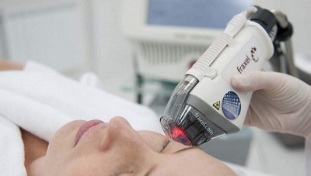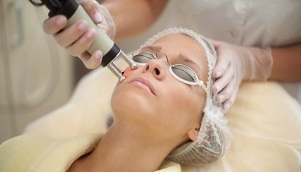
The main cause of skin aging is the deterioration of metabolism and the ability of cells to grow, as well as a delay in the excretion of toxins and toxins and a decrease in the supply of nutrients to cell structures. Thanks to laboratory work, it turned out that this is a reversible process, that is, there is always the possibility of activating cell activity. Scientists have discovered that after exposure to a laser, some cells in the dermis become active and others die. As a rule, dead cells die later than living cells that do not have the potential to regenerate.
During the death of weak cells, the empty intercellular space is filled by stronger cells. The visible heat effect after laser treatment activates cell activity, cells continue to renew and grow. The quality and speed of cell repair depends on the diameter of the laser beam. The thickness should not exceed 200 microns, then a healthy and young layer of skin will begin to form in the treated area.
For this reason, laser rejuvenation techniques have been improved with the application of fractional thermolysis. During this process, the laser beam is divided into many microscopic beams and creates an effective mesh structure in the treatment area. The innovative value of the technology lies in the fact that the laser works locally, protecting entire skin areas - accelerating skin renewal and improvement.
Fractional thermolysis assortments
Fractional laser rejuvenation has been used successfully to compress and strengthen the skin in one of two possible ways. They differ in the characteristics of the laser movement, the depth of penetration and the effect on certain areas.

The first method of action - fractional photothermolysis - affects the upper epidermal cells and evaporates in the true sense of the word. In other words, only the upper dermal layer is exposed to this method.
The second treatment affects the lower epidermal and dermal layers, leaving the top layer of skin untouched. In both cases there is a local effect of the laser beam. A cellular application zone is protected around the treated areas, which creates the potential for further skin regeneration. In other words, heat shock activates the growth of new cells and metabolic processes in the cells.
The first method of fractional photothermolysis cleans the surface microscopic areas of skin cells, tightens the treated areas in a short time, so the results after the procedure are immediately noticeable. It smoothes surface wrinkles and is therefore ideal for eliminating the first signs of age-related skin changes.
The second method of laser treatment is suitable for solving problems in the depths of the skin when the aging process is already irreversible. This method is a kind of "heavy artillery" of laser rejuvenation. The laser triggers metabolic processes in the deep layers of the epidermis and dermis, forms a new membrane framework, activates collagen production, thus rejuvenating the skin and rejuvenating it from within.
Maximum efficiency of fractional photothermolysis has been shown to be achieved by the combined use of two exposure methods. In this case, the skin will be doubly affected - both outside and inside, which provides a long-lasting effect of skin rejuvenation. A similar technique is used by many modern medical facilities with modern laser equipment.
procedure efficiency
After the first procedure after fractional laser rejuvenation, you can be sure that your skin is smooth, smooth and radiant. Within a week, the ovals of the face will be noticeably compressed, wrinkles will be corrected and the skin will be smoothed. A course of procedures over a period of one month will be required to consolidate and expand the result.
With the rejuvenation of the combined fraction, the effect of young skin is achieved faster and lasts longer, up to 2-3 years. Of course, the results depend on the patient's individual lifestyle. Abandoning bad habits, facial protection, a healthy lifestyle, and proper and proper sleep help to prolong the youth of the skin and prevent the aging and fading process.
The undoubted advantage of the procedure is its painlessness. The specialist uses superficial anesthesia, so during the procedure the patient feels only a slight tingling in the affected area.
Procedure Progress

The undoubted advantage of the procedure is its painlessness. The specialist applies superficial anesthesia, so during the procedure the patient feels only a slight tingling in the affected area. Anesthesia is applied shortly before the start of the session, the duration can be up to an hour - it all depends on the surface of the treatment.
After the procedure, the specialist advises the client on the necessary skin care and treats it with special drugs.
Immediately after the procedure, the skin does not need additional care. It will take a little more than a week to return to normal surgery, and postoperative rehabilitation is more difficult and takes longer.
For the first two days, the face will be swollen, after which it will turn a little red. After 4-7 days, the dead cells will begin to clear, fresh and young skin will appear.
Tips for the procedureIf you have any doubts about the effectiveness of fractional laser rejuvenation, you should visit the procedure to start based on the indications that are too much:
- Acne.
- Pigmentation.
- Spider veins, stretch marks and scars.
- Enlarged pores.
- Wrinkles, crow's feet around the eyes.
- Loose, dry and loose skin.
As with any salon procedure, there are a number of contraindications to fractional rejuvenation:
- Benign and malignant growths in the field of treatment.
- Cancer and ongoing chemotherapy
- Dermatoses and photodermatoses, in the field of procedure.
- Herpes infection for a month.
- Acute infectious infections, immunodeficiency.
- Chronic diseases such as bleeding disorders, diabetes, thromboembolic diseases.
- Psoriasis and hypertension.
- History of keloid scars or vitiligo, family history of vitiligo or keloids.
- Fresh tanning, final tanning trip.
- Pregnancy and lactation.
- Use of retinoids in the last six months.
Fractional rejuvenation with other procedures
combinationThis procedure is always performed only after prior consultation with a cosmetologist. With obvious changes associated with age, laser skin resurfacing will bring maximum effectiveness, not a fraction rejuvenation method.
In some cases, this will not be possible without surgical manipulations, such as endoscopic facelift, blepharoplasty, or the use of ropes for traction. However, laser rejuvenation will help maintain and increase the effectiveness of the procedures. It will complement the results and refine the customer's appearance.
It is perfectly combined with laser rejuvenation methods, mesotherapy and plasma removal, as well as procedures such as hyaluronic acid-based biorevitalization.







































